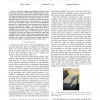Free Online Productivity Tools
i2Speak
i2Symbol
i2OCR
iTex2Img
iWeb2Print
iWeb2Shot
i2Type
iPdf2Split
iPdf2Merge
i2Bopomofo
i2Arabic
i2Style
i2Image
i2PDF
iLatex2Rtf
Sci2ools
ICRA
2009
IEEE
2009
IEEE
Qualitative robot localisation using information from cast shadows
— Recently, cognitive psychologists and others have turned their attention to the formerly neglected study of shadows, and the information they purvey. These studies show that the human perceptual system values information from shadows very highly, particularly in the perception of depth, even to the detriment of other cues. However with a few notable exceptions, computer vision systems have treated shadows not as signal but as noise. This paper makes a step towards redressing this imbalance by considering the formal representation of shadows. We take one particular aspect of reasoning about shadows, developing the idea that shadows carry information about a fragment of the viewpoint of the light source. We start from the observation that the region on which the shadow is cast is occluded by the caster with respect to the light source and build a qualitative theory about shadows using a region-based spatial formalism about occlusion. Using this spatial formalism and a machine vision ...
| Added | 23 May 2010 |
| Updated | 23 May 2010 |
| Type | Conference |
| Year | 2009 |
| Where | ICRA |
| Authors | Paulo Santos, Hannah M. Dee, Valquiria Fenelon |
Comments (0)

